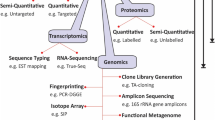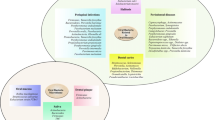Abstract
This study represents the first comprehensive analysis of the oral cavity of a late initial Holocene period individual from the Central Highlands of Córdoba, Argentina. We employed an innovative, multidisciplinary suite of methods that combine macroscopic dental analysis, cone beam computed tomography, vegetable microremains, and genetic data to the study of the oral health and diet of the past populations from the Central Highlands. Results indicate that this individual presented severe dental wear, a high amount of dental tartar, periapical lesions, and caries. Silicophytoliths and starch grains were identified, demonstrating the consumption and/or manipulation of wild plants. Finally, by applying paleogenetic techniques, we could confirm the presence of the bacterium Streptococcus mutans in this individual, and therefore more broadly, in ancient samples from Argentina. We additionally identified the presence of a second bacterium, Fusobacterium nucleatum.




Similar content being viewed by others
References
Alt KW, Türp JC, Wächter R (1998) Periapical lesions-clinical and anthropological aspects. In: Alt KW, Rösing FW, Teschler-Nicola M (eds) Dental Anthropology: Fundamentals, Limits and Prospects. Springer Vienna, Vienna, pp 247–276
Alt KW, Buitrago-Téllez CH (2004) Dental paleoradiology: applications in paleoanthropology and paleopathology. Can Assoc Radiol J 55:258–263
Ameghino F (1885) Informe sobre el Museo Antropológico y Paleontológico de la Universidad Nacional de Córdoba durante el año 1885. Bol Acad Nac Cienc 8:347–360
Arias TB, Colantonio S, Galetto L (2007) Knowledge and use of edible and medicinal plants in two communities from the Chaco Forest, Córdoba Province. Argent J Ethnobiol 27(2):218–232
Babot MP (2005) Silicophytoliths and calcium crystal in useful wild and domestic plants of Southern Andes. The Phytolitharien. Bull Soc Phytolith Res 17(2):20–21
Babot MP (2011) Cazadores-recolectores de los Andes Centro-Sur y procesamiento vegetal. Una discusión desde la Puna Meridional Argentina (ca. 7000–3200 años a.p.). Chungará 43:413–432
Babot MP, Oliszewski N, Grau A (2007) Análisis de caracteres macroscópicos y microscópicos de Phaseolus vulgaris (Fabaceae, Faboideae) silvestres y cultivados del Noroeste argentino. Una aplicación en arqueobotánica. Darwiniana 45:149–162
Babot MP, Musaubach MG, Plos A (2017) An archaeobotanical perspective in the study of inflorescence phytoliths of wild grasses from arid and semi-arid environments of Argentina. Quat Int 434:129–141
Correa A., Toledo J., and Calandri E. (2013) Estudio químico de los frutos de la “Palma Caranday” (Trithrinax campestris) y su posible uso como recurso alimenticio. III Congreso de alimentos en el Siglo XXI, XXXVI Reunión del Capítulo Argentino de la Sociedad Latinoamericana de Nutrición (Caslan). Mendoza.
De La Fuente C, Flores S, Moraga M (2013) DNA from human ancient bacteria: a novel source of genetic evidence from archaeological dental calculus. Archaeometry 55:767–778. https://doi.org/10.1111/j.1475-4754.2012.00707.x
Dias G, Tayles N (1997) “Abscess cavity”- a misnomer. Int J Osteoarchaeol 7:548–554
Fabra, M. (2014) Historia de las poblaciones prehispánicas del sector austral de las Sierras Pampeanas: variabilidad morfológica y modelos arqueológicos. Secretaria de Ciencia y Tecnología, FFyH, UNC. ISBN 978–950–33-1098-4. http://www.ffyh.unc.edu.ar/sites/default/files/e-books/EBOOK_FABRA.pdf
Fabra M, González CV (2015) Diet and oral health of populations that inhabited central Argentina (Córdoba province) during late Holocene. Int J Osteoarchaeol 25:160–175
Giovannetti MA, Lema VS, Bartoli CG, Capparelli A (2008) Starch grain characterization of Prosopis chilensis (Mol.) Stuntz and P. flexuosa DC, and the analysis of their archaeological remains in Andean South America. J Archaeol Science 35:2973–2985
González C, Fabra M (2018) Desgaste dental y hábitos dietarios en poblaciones arqueológicas del centro de Argentina. Arqueología 24(2):133–159
Greene TR, Kuba CL, Irish JD (2005) Quantifying calculus: a suggested new approach for recording an important indicator of diet and dental health. HOMO 56(2):119–132. https://doi.org/10.1016/j.jchb.2005.02.002
Hardy K, Blakeney T, Copeland L, Kirkham J, Wrangham R, Collins M (2009) Starch granules, dental calculus and new perspectives on ancient diet. J Archaeol Sci 36:248–255
Heider G, López L (2016) El consumo de recursos vegetales silvestres en grupos Cazadores Recolectores del Norte de Pampa Seca (San Luis y Córdoba, Argentina). Mundo de Antes 10:73–99
Henry A, Piperno D (2008) Using plant microfossils from dental calculus to recover human diet: a case study from Tell al-Raqa’i, Syria. J Archaeol Sci 35(7):1943–1950
Hillson S (2001) Recording dental caries in archaeological human remains. Int J Osteoarchaeol 11:249–289
Huynh HTT, Verneau J, Levasseur A, Drancourt M, AboudharamG (2016) Bacteria and archaea paleomicrobiology of the dental calculus: a review. Mol Oral Microbiol 31(3):234–242. https://doi.org/10.1111/omi.12118
ICSN. The International Code for Starch Nomenclature. 2011. Available at: http://www.fossilfarm.org/ICSN/Code.html, June 15, 2014.
Kerr NW (1988) A method of assessing periodontal status in archaeologically derived skeletal material. J Paleopathol 2:67–78
Koong B (2017) Atlas of oral and maxillofacial radiology. Wiley
Korstanje MA, Babot MP (2007) A microfossil characterization from South Andean economic plants. In: Jones MM, M.K. and Zurro D. (eds) Places, People and Plants: Using Phytoliths in Archaeology and Paleoecology (Proceeding of the 4th International Meeting on Phytolith Research). Oxbow Books, Cambridge, pp 41–72
Laguens, A. (1999) Arqueología del contacto hispano-indígena. Un estudio de cambios y continuidades en las Sierras Centrales de Argentina. BAR International Series 801, Oxford.
Laguens, A., D. Demarchi, and M. Fabra. (2007a) Un estudio arqueológico y bioantropológico de la colonización humana en el sector sur de las Sierras Pampeanas. In: Debates actuales en Arqueología y Etnohistoria. Universidad Nacional de Río Cuarto. ISBN 978–950–665-443-6. pp. 119–134.
Laguens A, Pautassi E, Sario G, Cattaneo R (2007b) Fishtail proyectil points from Central Argentina. Curr Res Pleistocene 24:55–57
Laguens A, Fabra M, Santos G, Demarchi D (2009) Palaeodietary inferences based on isotopic data for pre-Hispanic populations of the central mountains of Argentina. Int J Osteoarchaeol 19:237–249
Lieverse AR (1999) Diet and the aetiology of dental calculus. Int J Osteoarchaeol 9:218–232
López M. L. and Capparelli A. (2014) Algarrobo pods (Prosopis sp., leguminosae) in the Central and Northwestern Argentina. Food-traditional products and technological innovations involved in their manufacture. Work presented in VI International Congress of Ethnobotanical (ICEB), Córdoba, España.
Linossier A, Gajardo M, Olavarria J (1996) Paleomicrobiological study in dental calculus: Streptococcus mutans. Scanning Microsc 10(4):1005–1013
Lucas S, Sevin A, Passarius O, Esclassan R, Crubezy E, Grimoud AM (2010) Study of dental caries and periapical lesions in a mediaeval population of the southwest France: differences in visual and radiographic inspections. Homo 61(5):359–372. https://doi.org/10.1016/j.jchb.2010.06.003
Lukacs JR, Largaespada L (2006) Explaining sex differences in dental caries prevalence: saliva, hormones and ‘life history’ etiologies. Am J Hum Biol 18(4):540–555
Lukacs JR (2017) Dental adaptations of Bronze Age Harappans: occlusal wear, crown size, and dental pathology. Int J Paleopathol 18:69–81. https://doi.org/10.1016/j.ijpp.2017.05.008
Madella M, Alexandre A, Ball T (2005) International code for phytolith nomenclature 1.0. Ann Bot 96(2):253–260. https://doi.org/10.1093/aob/mci172
Medina M (2008) Diversificación económica y uso del espacio en el tardío prehispánico del Norte del valle de Punilla, Pampa de Olaen y Llanura Noroccidental (Córdoba, Argentina). Universidad de Buenos Aires, Argentina, Doctoral thesis
Medina M, Grill SC, López ML (2008) Palinología arqueológica: su implicancia en el estudiodel prehispánico tardío de las sierras de Córdoba (Argentina). Intersecciones en Antropología 9:99–112
Medina M, López L, Berberián E (2009) Agricultura y recolección en el tardío prehispánico de las Sierras de Córdoba (Argentina): el registro arqueobotánico de C. Pun. 39. Arqueología 15:217–230
Medina M, Pastor S, Berberián E (2014) “Es gente fazil de moverse de una parte a otra”. Diversidad en las estrategias de subsistencia y movilidad prehispánicas tardías (Sierras de Córdoba, Argentina). Complutum 25(1):73–88
Medina M, Pastor S, Recalde A (2016) The archaeological landscape of Late Prehispanic mixed foraging and cultivation economy (Sierras of Córdoba Argentina). J Anthropol Archeol 42:88–104
Montes A (1960) El hombre fósil de Miramar (Córdoba). Rev. Fac. Cs. Ex. Fis. y Nat., U.N.C., Serie Cs. Naturales 21(1 y 2):1–29
Musaubach MG (2012) Potencialidad de estudios arqueobotánicos sobre tártaro dental de cazadores-recolectores de la Provincia de La Pampa, Argentina. Rev Arg Antrop Biol 14:105–113
Nores R, Demarchi DA (2011) Análisis de haplogrupos mitocondriales en restos humanos de sitios arqueológicos de la provincia de Córdoba. Rev Arg Antrop Biol 13(1):43–54
Pastor, S. 2007. Arqueología del Valle de Salsacate y pampas de altura adyacentes (Sierras Centrales de Argentina). Una aproximación a los procesos sociales del período prehispánico tardío (900–1573 d.C.). PhD thesis, Universidad Nacional de La Plata, Unpublished.
Rivero, D. 2007. Ecología de cazadores-recolectores en las Sierras de Córdoba. Investigaciones en el sector meridional del Valle de Punilla y pampas de altura. PhD thesis, Facultad de Filosofía y Humanidades, Universidad Nacional de Córdoba, Unpublished.
Simón-Soro A, Mira A (2015) Solving the etiology of dental caries. Trends in microbiology 23(2):76–82. https://doi.org/10.1016/j.tim.2014.10.010
Siqueira JF, Rôças IN (2009) Diversity of endodontic microbiota revisited. J Dental Res 88(11):969–981. https://doi.org/10.1177/0022034509346549
Smith BH (1984) Patterns of molar wear in hunter-gatherers and agriculturalists. Am J Phys Anthropol 63:39–56
Tavarone A, Colobig M, Fabra M (2019) Late Holocene plant use in Lowland central Argentina: microfossil evidence from dental calculus. J Archaeol Sci Rep 26(2019):101895
Tek M, Metin M, Sener I, Bereket C, Tokac M, Kazancioglu HO, Ezirganli S (2013) The predominant bacteria isolated from radicular cysts. Head Face Med 9:25. https://doi.org/10.1186/1746-160X-9-25
Warinner C (2016) Dental calculus and the evolution of the human oral microbiome. CDA Journal 44 (7):411-420.
Warinner C, Rodrigues JF, Vyas R (2014) Pathogens and host immunity in the ancient human oral cavity. Nat Gen 46(4):336–344
Wasterlain SN, Cunha E, Hillson S (2011) Periodontal disease in a Portuguese identified skeletal sample from the late nineteenth and early twentieth centuries. Am J Phys Anthropol 145:30–42. https://doi.org/10.1002/ajpa.21464
Xin X, Yuan Z, Wenyuan S, Yaling L, Xuedong Z (2015) Biofilm and dental caries. In: Xuedong Z (ed) Dental Caries. Principles and Management, pp 27–58
Zerón GVA, Porras LD (2016) Fusobacterium nucleatum ¿Un patógeno periodontal promotor de carcinogénesis colorrectal? Rev ADM 73(6):280–285
Zhou X, LI Y. (2015) Atlas of oral microbiology from healthy microflora to disease, 1st edn. Academic press
Acknowledgments
The authors are grateful to Centro de Investigaciones Científicas y Transferencia de Tecnología a la Producción (CICYTTP-CONICET- Diamante, Entre Ríos, Argentina), especially Eliana Moya, for their support and collaboration. We would like to thank Marcos Salvatore for the map, and to Carolina Mosconi and Graciela Cabana for English proofreading. The authors are solely responsible for the ideas expressed in this work.
Funding
This work was supported by the following grants: FONCyT PICT 2015-3155, MinCyT Córdoba PID 2018-79, and SeCyT-UNC 2016-2018. PUE 2016 CONICET.
Author information
Authors and Affiliations
Corresponding author
Ethics declarations
This article does not contain any studies with living human participants or animals performed by any of the authors.
Conflict of interest
The authors declare that they have no conflict of interest.
Additional information
Publisher’s note
Springer Nature remains neutral with regard to jurisdictional claims in published maps and institutional affiliations.
Rights and permissions
About this article
Cite this article
Tavarone, A., Ramírez, D., González, C. et al. Multidisciplinary perspectives on the study of ancient diet and oral health. A case study from the central region of Argentina. Archaeol Anthropol Sci 12, 47 (2020). https://doi.org/10.1007/s12520-019-00965-7
Received:
Accepted:
Published:
DOI: https://doi.org/10.1007/s12520-019-00965-7




